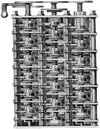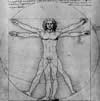Class Activity What is in Your Database?
Objective:
Students will ask how their art projects will be different or will change,
based upon their collections of images (the images are to be provided
by the instructor). Students will engage in a discussion of how artist
invention figures in working with limits on interactive works. The
exercise
equips students with the ability to sculpt information and synthesize
new relationships, assisting with the story component of project
one.
This activity is a companion, image-based exercise of the
listing exercise.
Background: Artists begin to visualize their
work prior to creating it through doing many things, but collecting imagery
or information on their topic of interest, serves to constrain art-making
practices. Why does this use of collections open up possibilities at the
same time it ties itself to the world?
A hint for the answer can be gained from looking closer
at the word, "database". The second part of the word is "base".
In economic theory, the base refers to the raw materials or supplies or
low-level technologies that drive commerce and industry. The data-base
then is an information base, a collection of raw materials, but not iron
or aluminum, or lathes, but information resources.
Whether you are a scientist sequencing genetic code,
or a novelist attempting to effect political change, information shapes
how we make our science, literature and art. Research is emerging as
a
strategy of success in the information arts and sciences. A little
information can be useful as well as detrimental to an engaging information
artwork. At the same time, too much information can be very time-consuming
without our ability to absorb everything on a given subject. Still,
it
can also open up possibilities.
Students will act as information architects in a class
discussion, asking what kind of artwork can be made from a given selection
of images.
    
  
   
|

